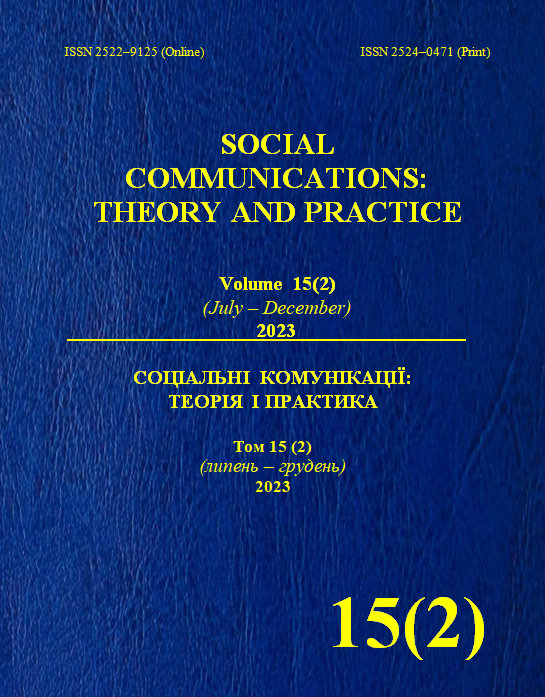Почуття сорому – інвазивні та захисні форми соціального спілкування
DOI:
https://doi.org/10.51423/2524-0471-2023-15-2-3Ключові слова:
сором, шеймінг, етнічні сім’ї, інвазивні та захисні форми соціальної комунікаціїАнотація
Сім’ї з міграційним походженням й обмеженим соціальним і культурним капіталом часто відчувають сором і ганьбу унікальними способами. У статті розглянуто соціальні аспекти згаданих переживань, зазначено, що сором – це не особиста схильність, а почуття несхвалення або відторгнення з боку спільноти, чиї цінності поважаються та визнаються законними.
У статті розрізняють інвазивну та захисну форми соціальної комунікації. Інвазивні форми ізолюють людей і ускладнюють у них формування позитивної самооцінки, тоді як захисні форми допомагають їм відновити соціальну повагу, яку вони могли втратити внаслідок сорому.
Використовуючи практико-орієнтоване та засноване на кейсі дослідження, стаття описує й аналізує чотири випадки, що призводять до трьох різних фігур сімейного сорому. Сім’ї – це óбрази, що розвиваються та змінюються як через внутрішні (наприклад, конфлікти, прихильність, самообмеження), так і через зовнішні (наприклад, культурні цінності, соціальні норми, зовнішні обмеження) фактори. Боротьба й відмінності влади в сім’ї, а також символічна сила культурних традицій і вірувань визначають, яку форму набуває образ і як його можна змінити. Закріплюючи досвід сорому в соціальному просторі сім’ї, концепція диспозиційного сорому розширюється контекстуальним виміром.
У маргіналізованому типі сім'ї родина часто передає й підсилює соціальні очікування етнічної спільноти, зберігаючи домінантні цінності й залишаючи окремих членів відчувати себе незначними. В інших образах сім’я розглядається як місце внутрішньої боротьби за статус і як простір, що захищає членів від відчуженого погляду інших.
Результати дослідження важливі тим, що сім’ї, які брали участь у дослідженні, погано інтегровані в данське суспільство та представляють різні форми життя на маргінесі суспільства.
Завантаження
Посилання
Bahrdt, H. P. (1992). Schlüsselbegriffe der Soziologie: Eine Einführung mit Lehrbeispielen (5. Auflage). München : CH Beck. [in German].
Benedict, R. (1946). The Chrysanthemum and the Sword. Patterns of Japanese Culture. Boston : Houghton Mifflin.
Berndsen, M., & Gausel, N. (2015). When majority members exclude ethnic minorities: The impact of shame on the desire to object to immoral acts. European journal of social psychology, 45(6), 728-741.
Bonke, J., & Schultz-Nielsen, M. L. (2013). Integration blandt ikke-vestlige Indvandrere - Arbejde, Familie, Netværk og Forbrug. Syddansk Universitet. Institut for Grænseregionsforskning. Syddansk Universitetsforlag. [in Danish].
Bryant‐Davis, T., Adams, T., Alejandre, A., & Gray, A. A. (2017). The trauma lens of police violence against racial and ethnic minorities. Journal of Social Issues, 73(4), 852-871.
Cloerkes, G. (2001). Soziologie der Behinderten. Eine Einführung. Heidelberg : Universitätsverlag Winter [in German].
Czub, T. (2013). Shame as a self-conscious emotion and its role in identity formation. Polish Psychological Bulletin, 3(44), 245-253.
Elias, N. (1990). Engagement und Distanzierung. Arbeiten zur Wissenssoziologie I (8. Auflage). Frankfurt am Main : Suhrkamp [in German].
Elias, N. (1996). Was ist Soziologie? Weinheim : Juventa Verlag [in German].
Ferrey, A. E., et al. (2016). The impact of self-harm by young people on parents and families: a qualitative study. BMJ open, 6(1), e009631.
Flyvbjerg, B. (2006). Five misunderstandings about case-study research. Qualitative inquiry, 12(2), 219-245.
Honneth, A. (2003). Kampf um Anerkennung. Zur moralischen Grammatik sozialer Konflikte. Frankfurt am Main : Suhrkamp [in German].
Landweer, H. (1999). Scham und Macht: Phänomenologische Untersuchungen zur Sozialität eines Gefühls (Vol. 7). Tübingen : Mohr Siebeck [in German].
Leeming, D., & Boyle, M. (2004). Shame as a social phenomenon: A critical analysis of the concept of dispositional shame. Psychology and psychotherapy: Theory, research and practice, 77(3), 375-396.
Lindsay, S., et al. (2014). Social workers as “cultural brokers” in providing culturally sensitive care to immigrant families raising a child with a physical disability. Health & Social Work, 39(2), e10-e20.
Lorenzer, A. (2016). Das Konzil der Buchhalter: Die Zerstörung der Sinnlichkeit. Eine Religionskritik. Frankfurt am Main : S. Fischer Verlag. [in German].
Lynd, H. M. (1958). On shame and the search for identity. New York : Harcourt, Brace & World
Neckel, S. (2021). Scham und Schamsituationen aus soziologischer Sicht. Trauma – Zeitschrift für Psychotraumatologie und ihre Anwendungen. 19 Jg. Heft 1, 94-108. [in German]
Nieman, S. (2010). Moralische Klarheit. Ein Leitfaden für erwachsene Idealisten. Hamburg : Hamburger Edition [in German].
Rumbaut, R. G. (1994). The crucible within: Ethnic identity, self-esteem, and segmented assimilation among children of immigrants. International migration review, 28(4), 748-794.
Scheler, M. (1957). Über Scham und Schamgefühl. Schriften aus dem Nachlass. Bd. 1: Zur Ethik und Erkenntnislehre (Vol. 10). Francke, S. 80 [in German].
Schröter, M. (1990). Scham im Zivilisationsprozeß. Zur Diskussion mit Hans Peter Duerr. In Hermann Korte (Hrsg.), Gesellschaftliche Prozesse und individuelle Praxis. Frankfurt am Main : Suhrkamp, S. 42-85. [in German].
Serviceloven; https://danskelove.dk/serviceloven/50 ; aufgerufen am 06.08.23 [in Danish]
Simmel, G. (1901). Zur Psychologie der Scham. In: Simmel, G. (1989) Georg Simmel: Schriften zur Soziologie. Frankfurt am Main : Suhrkamp, 140-150. [in German].
Smith, E. & Traustadóttir, R. (2015). Childhood Disability, Identity and the Body. In: Traustadóttir, R., Ytterhus, B., Egilson, S., & Berg, B. (Eds.). (2015). Childhood and disability in the Nordic countries: Being, becoming, belonging. New York : Palgrave
The William Davidson Talmud. Bava Metzia 58 b/12 https://www.sefaria.org/Bava_Metzia.58b.12?lang=bi
Waldenfels, B. (2015). Sozialität und Alterität: Modi sozialer Erfahrung. Frankfurt am Main : Suhrkamp Verlag. [in German].
Wurmser, L. (1990). Die Maske der Scham. Die Psychoanalyse von Schamaffekten und Schamkonflikten. Berlin, Heidelberg : Springer. [in German]
Zahavi, D. (2013). Scham als soziales Gefühl 1. Phänomenologische Forschungen, 319-337. [in German].
Опубліковано
Як цитувати
Номер
Розділ
Ліцензія
Авторське право (c) 2023 Ханс Ельбесхаузен, Ахмет Демір

Ця робота ліцензується відповідно до Creative Commons Attribution 4.0 International License.
Кожний автор може детально дізнатися про умови ліцензії - https://creativecommons.org/licenses/by/4.0/legalcode













